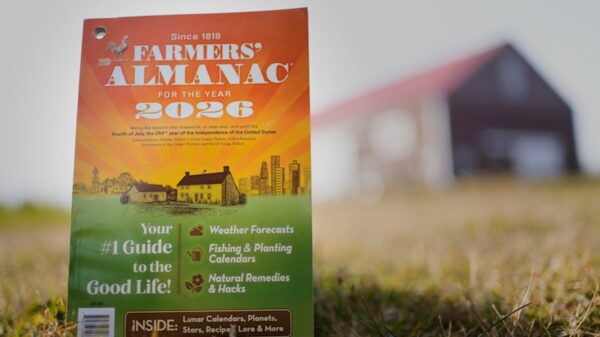The Farmers’ Almanac, a staple of American publishing for over two centuries, will cease its operations after the release of its final edition in 2026. The announcement, made by editors Sandi Duncan and Peter Geiger, marks the end of a publication that has provided weather forecasts, gardening advice, and practical tips since its inception in 1818.
Founded by poet and astronomer David Young in New York, the first edition spanned 36 pages and included content on lunar phases, weather predictions, and even jokes. Over the years, the almanac developed a reputation as one of the best-selling publications in American history, adapting to the evolving needs of farmers and gardeners alike.
Challenges Contribute to Closure
The decision to discontinue the almanac stemmed from “growing financial challenges” in today’s rapidly changing media landscape, according to the editorial team. In their statement, they expressed deep appreciation for the publication’s long history, saying, “It is with a great appreciation and heartfelt emotions that we write to share some sad news.” They also confirmed that access to the almanac’s website would remain available until December.
Despite its closure, the almanac’s legacy is significant. It has weathered numerous changes in media consumption, from the emergence of daily newspapers and the establishment of the National Weather Service in 1870 to the rise of the internet and social media.
The Old Farmer’s Almanac, which has been in circulation since 1792, will not face a similar fate. In a statement released last week, it assured its readers that it “isn’t going anywhere,” highlighting the competitive landscape within the almanac genre.
A Historical Perspective
During its peak, particularly under the leadership of its sixth editor, Raymond Geiger, the Farmers’ Almanac saw circulation soar from 86,000 in the 1930s to an impressive 4 million copies by 1994. Geiger, who continued editing while serving in World War II, played a crucial role in the publication’s expansion and popularity. Following his passing, his son Peter Geiger took over the editorial reins.
Historically, the Farmers’ Almanac was often distributed in bulk to banks and insurance companies, which would imprint their names and give them to clients. Over time, it adapted to modern retail by offering its content online and in stores.
One notable anecdote from its history involves the future President Abraham Lincoln, who reportedly used a copy of the almanac as evidence in a court case in 1857. By highlighting discrepancies in lunar data, he successfully defended his client against murder charges.
While the publication may be ending, its editors emphasized that its wisdom will endure. They encouraged readers to continue sharing the almanac’s timeless advice, stating, “So go ahead – plant your peas when the daffodils bloom. Watch for a red sky at night. Tell the kids how granddad always swore by the Almanac.” This sentiment encapsulates the enduring spirit of a publication that has been a fixture in American culture for over two centuries.



































































